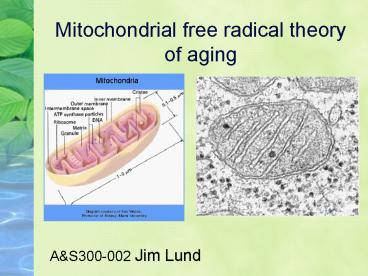Mitochondrial free radical theory of aging - PowerPoint PPT Presentation
1 / 21
Title:
Mitochondrial free radical theory of aging
Description:
First proposed in 1972 by Harman, further refined and ... Rats (4 yr lifespan) and pigeons (35 yrs). Pigeon mitochondria leak only 30% of the free ... – PowerPoint PPT presentation
Number of Views:483
Avg rating:3.0/5.0
Title: Mitochondrial free radical theory of aging
1
Mitochondrial free radical theory of aging
- AS300-002 Jim Lund
2
Mitochondrial free radical theory of aging
- Oxidative damage theory
- Proposed by Denham Harman, 1956.
- Mitochondrial free radical theory
- First proposed in 1972 by Harman, further refined
and developed in 1980 by Jaime Miquel.
3
Oxidative damage
- 95 of a cells energy is produced in the
mitochondria. - Most O2 is utilized in the mitochondria.
- O2 is required for animal life, but O2 is
damaging--high concentrations are toxic to most
plants and animals.
4
Oxidative damage
- Pure O2 damages human lungs--long enough exposure
permanently damages the aveoli. - Why is O2 toxic?
- The damaging effects are due primarily to damage
caused by free radicals. - Formation of AGEs occur at much slower rates.
5
Free radicals
- Free radical a chemical with an odd number of
electrons. - Chemicals with an unpaired electron are highly
reactive, readily combine with other molecules. - Most chemical reactions in a cell are well
controlled--require specific starting conditions
or enzymes. But free radicals are
thermodynamically unstable and can react with
most molecules and break most covalent bonds.
6
Free radicals
- Normal bond represents a pair of elections
- Breaking a bond AB -gt A- B
- Products are ions.
- Free radical formation
- AB -gt A B
- Products each have an unpaired electron!
- Free radical breakdown of H2O
- HOH -gt OH H
- Forms Hydroxyl radical and hydrogen radical.
7
Stages of free radical reactions
- Initiation, Propagation, and Termination
- Initiation
- Oxygen (O2) is reduced in mitochondria in one
electron steps. Oxygen with an unpaired electron
often escapes as O2, called superoxide radical. - 23 of the oxygen atoms taken up by mitochondria
escape as free radicals! - O2 quickly reacts with H2O2
- O2 H2O2 -gt OH OH- O2
- Propagation
- Free radicals can propagate indefinitely
- R O2 -gt ROO
- ROO -gt ROOH R
8
Stages of free radical reactions
- Initiation, Propagation, and Termination
- Termination
- R R -gt RR
- R ROO -gt ROOR
- 2 ROO -gt ROOR O2
- Antioxidant H ROO -gt Antioxidant ROOH
- Termination occurs when free radicals react with
other free radicals or antioxidant molecules.
9
Cellular free radical defense
- Compartmentalization
- Most oxidative metabolism and free radical
production occurs at the inner mitochondrial
membrane. - Protective enzymes
- Several SOD, catalase, glutathione peroxidase.
- 2H O2 O2 --SOD-gt O2 H2O2
- H2O2 H2O2- --CAT-gt H2O O2
- Concentrated in the mitochondria.
- Antioxidant molecules
10
Evidence for the oxidative damage theory
- Correlation between species-specific levels of
anti-oxidant defenses and lifetime energy
expenditure (Cutler, 1984). - Correlations stronger between mitochondrial
(MnSOD) than cytoplasmic (CuSOD, ZnSOD) defense
levels.
11
Free radical scavenging systems
12
Evidence for the oxidative damage theory
- Comparison of mammals and birds
- Rats (4 yr lifespan) and pigeons (35 yrs).
- Pigeon mitochondria leak only 30 of the free
radicals than those from rat. - (Herrero and Barja, 1997).
- Antioxidant EUK-134
- Fed to C. elegans, increased mean and maximum
lifespan 44 - Fed to mev-1, lifespan only 60 of wt, restores
lifespan to same as wt. - (Giblin et al., 2003)
13
Activity in houseflies experiment
- Raised houseflies in either
- Large chamber, could fly (high activity)
- Low chamber, flies only walk (low activity)
- Low activity animals had longer mean and max
lifespan, lower rate of lipofuscin formation. - Catalase activity high in young flies, decreases
with age. - Peroxide levels (a measure of lipid oxidation)
low in young flies, increase with age. - Sohal and Donato, 1978.
14
Testing the oxidative damage theory
- Construct long-lived and short-lived animals and
then assay their antioxidant defense levels. - Construct animals with genetically altered
levels of antioxidant defense enzymes and then
test for lifespan.
15
Testing the oxidative damage theory
- Construct long-lived and short-lived animals and
then assay their antioxidant defense levels. - Construct animals with genetically altered
levels of antioxidant defense enzymes and then
test for lifespan.
16
Effect of altered levels of SOD and catalase in
fly
- See Orr and Sohal, 1994
- http//www.ncbi.nlm.nih.gov/entrez/query.fcgi?cmd
RetrievedbpubmeddoptAbstractlist_uids8108730
query_hl24itoolpubmed_docsum - See Phillips et al., 2000
- http//www.ncbi.nlm.nih.gov/entrez/query.fcgi?cmd
RetrievedbpubmeddoptAbstractlist_uids1111359
9query_hl21itoolpubmed_docsum
17
Metabolic rate declines with age
Biology of Aging, R. Arking, 3rd ed.
18
Focus on mitochondria
- Damage to mitochondrial genome!
- Impaired mitochondrial gene expression.
- Inability of mitochondria to replicate, divide,
further reducing energy production, etc. - Damaged mitochondria replicate faster than intact
mitochondria.
19
Mitochondrial damage
- Young samples intact mitochondrial DNA
- Old samples most mitochondrial DNA has deletion.
- Damage accumulates exponentially.
- Observed in a wide range of animals, from C.
elegans to humans.
20
8-oxodG/105dG in nuclear DNA
See Barja and Herrero, 2000 http//www.ncbi.nlm.n
ih.gov/entrez/query.fcgi?cmdRetrievedbpubmeddo
ptAbstractlist_uids10657987query_hl25itoolp
ubmed_docsum
21
8-oxodG/105dG in mitochondiral DNA
See Barja and Herrero, 2000 http//www.ncbi.nlm.n
ih.gov/entrez/query.fcgi?cmdRetrievedbpubmeddo
ptAbstractlist_uids10657987query_hl25itoolp
ubmed_docsum
Heart Brain































